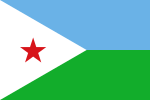 |
| Part of a series on the |
| Culture of Djibouti |
|---|
| Culture |
| People |
| Religion |
| Language |
| Politics |
|
|
The culture of the Republic of Djibouti is diverse, due to the nation's Red Sea location at a crossroads of trade and commerce.
Djiboutian population is divided into several human components: the Issa and the Anfar, the Muslim religion for the most part, that are traditionally attached to anthropological group Hamitic. They were called "Hamites Orientals" to distinguish them from these other Hamites that are Egyptians and Berbers. An important Arab community of Yemeni origin, is also based in Djibouti.
The Afars and the Issa Somalis who are characterized by slender physique, regular features, and proud bearing, they speak different Cushitic languages from the great Afroasiatic language family, and traditionally lived as nomadic pastoralists. However, the population tends to settle because today more than half of its citizens live in the capital and the towns and villages of the interior. This land, traditional crossing point between Egypt, Sudan and Saudi crossroads of nations between Africa and Asia, has likely undergone mixing of populations who have played an important role in the fate of the original peoples of the Djibouti nation. Poetry traditionally recited in the villages by special readers called gabaye was a way of recording the community's history and customs, as well as current events.